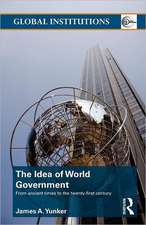Post-Soviet Political Order
Editat de Barnett Rubin, Jack Snyderen Limba Engleză Paperback – 9 apr 1998
* the institutional legacy of empire
* the social processes unleashed by imperial collapse
* patterns of bargaining within and between states to resolve conflicts arising out of the imperial collapse
* the impact of the wider international setting on the pattern of post-imperial politics
Focusing on the former Soviet Union and Eastern European countries, the contributors show how strong state institutions are essential if conflict and political instability are to be avoided.
Preț: 307.45 lei
Nou
Puncte Express: 461
Preț estimativ în valută:
58.83€ • 61.58$ • 48.97£
58.83€ • 61.58$ • 48.97£
Carte tipărită la comandă
Livrare economică 31 martie-14 aprilie
Preluare comenzi: 021 569.72.76
Specificații
ISBN-13: 9780415170697
ISBN-10: 0415170699
Pagini: 214
Dimensiuni: 156 x 234 x 19 mm
Greutate: 0.4 kg
Ediția:1
Editura: Taylor & Francis
Colecția Routledge
Locul publicării:Oxford, United Kingdom
ISBN-10: 0415170699
Pagini: 214
Dimensiuni: 156 x 234 x 19 mm
Greutate: 0.4 kg
Ediția:1
Editura: Taylor & Francis
Colecția Routledge
Locul publicării:Oxford, United Kingdom
Public țintă
Postgraduate and UndergraduateCuprins
1. Introduction: Reconstructing Politics Amidst the Wreckage Of Empire Jack Snyder 2. After Empire: Competing Discourses and Interstate Conflict in Postimperial Eastern Europe Alexander J. Motyl 3. The Great War and the Mobilization of Ethnicity in the Russian Empire Mark von Hagen 4. Will Russia Survive? Center and Periphery in the Russian Federation Steven Solnick 5. Ethnolinguistic and Religious Pluralism and Democratic Construction in Ukraine Jose Casanova 6. Possibilities for Conflict and Conflict Resolution in Post-Soviet Central Asia Rajan Menon and Hendrik Spruyt 7. Russian Hegemony and State Breakdown in the Periphery: Causes and Consequences of the Civil War in Tajikistan Barnett R. Rubin 8. Conclusion: Managing Normal Instability Barnett R. Rubin
Descriere
Post-Soviet Political Order analyses the institutional patterns of the former Soviet Union and Eastern European countries. The contributors show how strong state institutions are essential if political instability is to be avoided.














